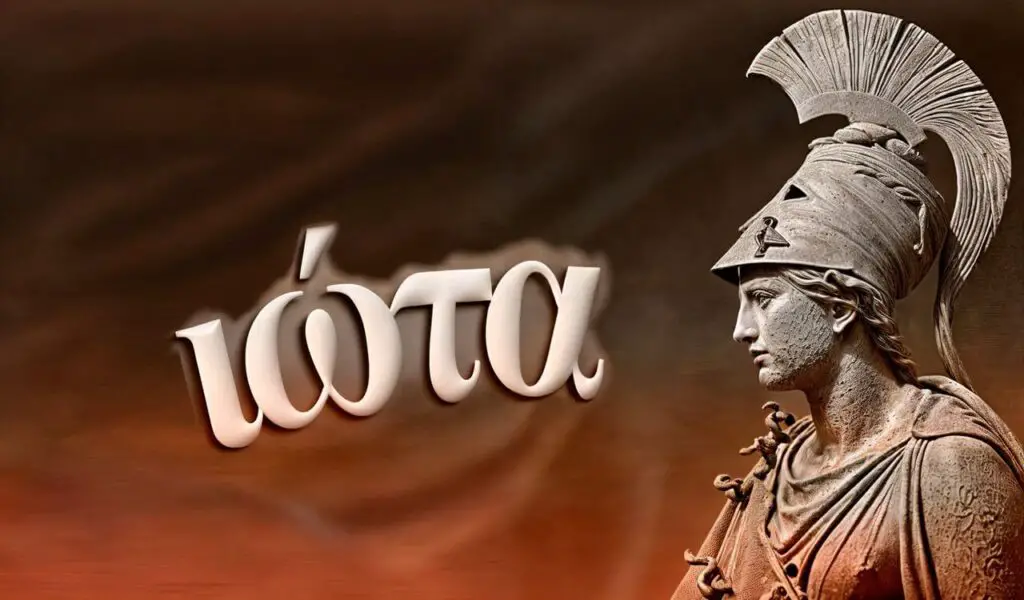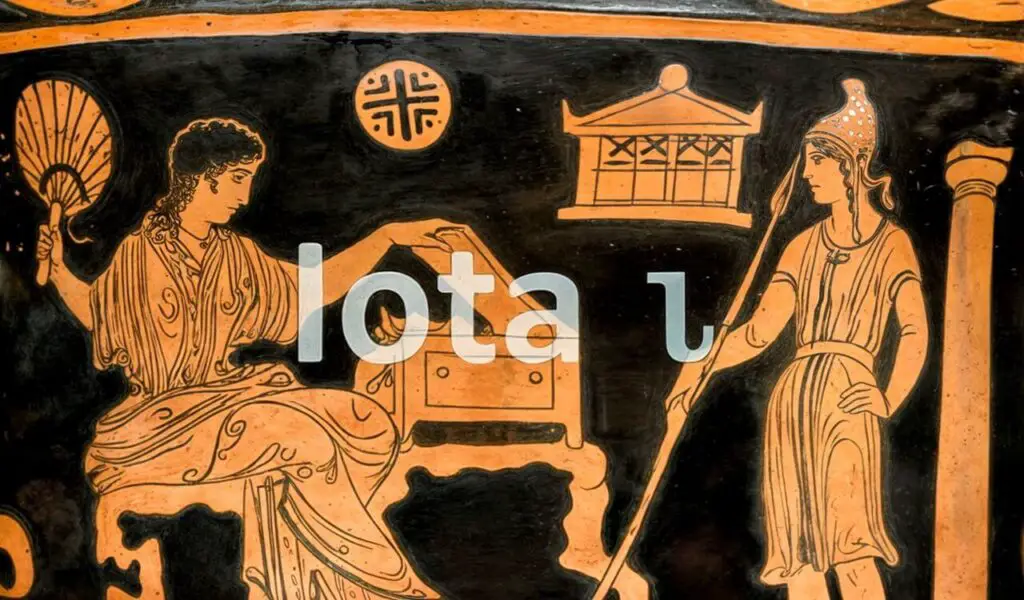The Greek alphabet, with its rich tapestry woven through the annals of history, stands as a testament to the enduring legacy of ancient civilizations and their impact on modern languages and cultures. Its symbols have traversed the corridors of time, influencing not just linguistic structures but also the very fabric of scientific, philosophical, and artistic discourse worldwide. At the heart of this exploration lies a peculiar inquiry into the absence of the letter ‘J’ in the Greek alphabet—a gap bridged by the letter ιώτα (Iota), a character steeped in linguistic, cultural, and historical significance.
This absence is not merely a trivial detail but a gateway to understanding the intricate relationship between alphabets, sounds, and the evolution of language. The Greek alphabet, unlike its Latin counterpart, does not include the letter ‘J’, leading to intriguing adaptations and interpretations across languages that have adopted Greek roots or terminologies. Ιώτα, the ninth letter of the Greek alphabet, serves as a fascinating focal point for this exploration, embodying both the simplicity and complexity of Greek linguistic tradition.
For language enthusiasts, historians, and the culturally curious, delving into the reasons behind the absence of ‘J’ and the prominence of ιώτα in the Greek alphabet is more than an academic exercise. It offers a lens through which to view the interplay between language, culture, and history, revealing how alphabets are not just arbitrary collections of sounds but rich cultural artifacts that reflect the philosophies, technologies, and aesthetics of their times. Understanding ιώτα’s role illuminates aspects of Greek culture, mythology, and intellectual life, offering insights into how a single letter can influence the development of language, thought, and culture across centuries.
In this exploration, we will unravel the layers of history, phonology, and cultural significance surrounding ιώτα, shedding light on its pivotal role in the Greek alphabet and its broader implications for the study of language and culture. From its phonetic peculiarities to its symbolic resonance in Greek mythology and philosophy, ιώτα serves as a bridge connecting the ancient world with modern times, inviting us to reflect on the profound connections between past and present, sound and meaning, tradition and innovation.
The Greek Alphabet Overview

The Greek alphabet, a cornerstone of linguistic heritage, marks a pivotal transition from ancient scripts to the alphabets in use today. Its origins trace back to the 8th century BCE, emerging from the Phoenician alphabet—a semitic script from which the Greek alphabet borrowed heavily, adapting it to suit the sounds of the Greek language. This adaptation was revolutionary, introducing vowels into the script, a feature that distinguished the Greek alphabet from its predecessors and influenced the development of subsequent alphabetic systems, including the Latin alphabet from which the English alphabet is derived.
The Greek alphabet consists of 24 letters, each representing a unique sound. This one-to-one correspondence between letter and sound was a significant advancement in the development of writing systems, facilitating literacy and the spread of ideas. Unlike the Latin alphabet, which evolved to include the letter ‘J’ to represent a consonant sound, the Greek alphabet has no direct equivalent, relying instead on letters like ιώτα to represent vowel sounds.
Ιώτα, the ninth letter of the Greek alphabet, is particularly noteworthy. Its simplicity in form—a single stroke or dot—belies its importance in the phonetic system of the Greek language. Representing the sound [i], ιώτα plays a critical role in the Greek vowel system, appearing in a myriad of words and serving as a building block for various diphthongs and vowel combinations. The presence of ιώτα highlights the Greek alphabet’s structure and characteristics, emphasizing its differences from and influences on the Latin alphabet and, by extension, the modern English alphabet.
Understanding the structure and evolution of the Greek alphabet, including the role of ιώτα, is not just an exercise in historical linguistics. It sheds light on the interconnectedness of cultures and languages, demonstrating how alphabets adapt and evolve to meet the needs of their speakers. The Greek alphabet, with its rich history and unique features, serves as a reminder of the complexity of language and its development over millennia.
The exploration of ιώτα within this context provides a lens through which to examine the nuances of the Greek language and its alphabet. As a key letter, ιώτα embodies the precision and elegance of Greek phonology, offering insights into the ways in which language and writing systems reflect and shape human thought and culture. Through this lens, we can appreciate the Greek alphabet not just as a tool for communication, but as a cultural artifact that carries the legacy of ancient Greece into the modern world, influencing everything from scientific terminology to philosophical discourse.
Understanding Iota (Ιώτα): The Closest Element to ‘J’
Ιώτα, occupying a distinctive place in the Greek alphabet, is more than a mere letter; it is a bridge connecting ancient phonetics to modern linguistics, encapsulating the evolution of sound and script across millennia. Despite its seemingly simple appearance—a small curve or stroke—it carries profound linguistic weight and historical depth. Ιώτα represents the vowel sound [i], akin to the ‘ee’ in ‘see’ or the ‘i’ in ‘machine’, a sound prevalent in many languages but represented differently in writing systems around the world.
The absence of a direct equivalent to ‘J’ in the Greek alphabet, and the role of ιώτα in filling part of this phonetic gap, presents an intriguing linguistic puzzle. Historically, the ‘J’ sound, as it exists in English and several other languages, evolved from the Latin ‘I’, which itself had diverged into vowel and consonantal sounds. Greek, with its own path of phonological evolution, utilized ιώτα to represent the [i] sound, without necessitating a separate letter for the consonantal counterpart that ‘J’ represents in the modern alphabets derived from Latin.
This distinction underscores a fundamental aspect of language: the representation of sounds is not universal, but deeply rooted in the cultural and historical contexts of a language’s speakers. Ιώτα’s role in the Greek language is a testament to this, embodying the idea that language is a living, evolving entity, shaped by the needs, innovations, and interactions of its users. The adaptation and utilization of ιώτα in various linguistic contexts—ranging from the classical era to Byzantine texts and beyond—illustrate its versatility and enduring significance.
The symbolism and usage of the iota symbol extend beyond phonetics. In mathematics and science, ιώτα has been appropriated to denote various concepts, from small quantities to specific functions, reflecting the Greek alphabet’s lasting influence on scholarly and scientific discourse. Furthermore, the term ‘iota’ has permeated the English language as a metaphor for minuteness or triviality, demonstrating the cultural transmission of linguistic elements across languages and epochs.
Understanding ιώτα also involves exploring its pronunciation and graphical variations. In different dialects and historical periods of Greek, ιώτα’s pronunciation has ranged from a pure vowel sound to part of diphthongs, showcasing the dynamic nature of spoken language. Visually, ιώτα has been represented in various scripts, from the monumental inscriptions of ancient stones to the minuscule handwriting of medieval manuscripts, each form reflecting the aesthetic and practical considerations of its time.
In essence, ιώτα encapsulates the complexity of language’s evolution—how sounds are represented, how they change over time, and how they carry meaning beyond their auditory or visual forms. The exploration of ιώτα is not just an examination of a single letter but a deep dive into the heart of linguistic innovation, cultural exchange, and the enduring legacy of the Greek alphabet in shaping the way we communicate and understand the world around us.
The Myth of ‘J’ in the Greek Alphabet

The narrative surrounding the absence of the letter ‘J’ in the Greek alphabet is a fascinating intersection of linguistics, history, and cultural evolution. This absence is not an oversight but a reflection of the phonetic landscape of the Greek language and its script’s development. The evolution of alphabets across cultures showcases a diversity of approaches to representing sounds, and the Greek alphabet’s structure is a testament to this diversity. The story of ‘J’ in Greek is essentially a non-story, as the Greek phonetic system never developed a sound corresponding directly to the ‘J’ found in modern languages like English and French.
This situation underscores the adaptability and fluidity of alphabetic systems. Alphabets are not static but evolve in response to the changing needs of the languages they represent. The Greek alphabet, derived from the Phoenician script, was innovative in its introduction of vowels, setting a precedent for future alphabetic systems. However, the sounds of a language are tied to its speakers’ oral traditions, and the Greek language, with its array of sounds, found no use for the ‘J’ sound that would later emerge in the Latin alphabet and its descendants.
The adaptation of the Greek alphabet to other languages—most notably through the Latin alphabet’s evolution—highlights the complexities of phonetic representation. When the Roman Empire adopted the Greek script, modifications were made to accommodate the sounds of Latin, leading to the development of new letters, including ‘J’. This adaptation process reflects the broader narrative of cultural exchange and linguistic borrowing that has shaped human communication over millennia.
Greek orthography and phonology provide insight into why certain sounds are represented as they are—or are not represented at all. The Greek language has a rich array of consonantal and vowel sounds, meticulously mapped out by the alphabet. The system of vowels, in particular, is nuanced, with letters such as ιώτα playing multiple roles in denoting sound variations. This precision in phonetic representation highlights the Greek alphabet’s efficiency and elegance, underscoring the absence of a ‘J’ sound as a matter of linguistic evolution rather than omission.
In exploring the myth of ‘J’ in the Greek alphabet, it becomes clear that language is a living entity, shaped by historical, cultural, and social forces. The absence of ‘J’ speaks to the unique path of the Greek language and its script, reflecting a broader narrative of human communication’s adaptability and diversity. Understanding this aspect of Greek linguistics offers a window into the intricate relationship between speech, writing, and cultural identity, reminding us of the alphabet’s role not just as a tool for recording language but as a reflection of the people who use it.
Cultural and Linguistic Influence of Iota (Ιώτα)
The influence of ιώτα in the Greek language and culture extends far beyond its phonetic role, intertwining with the fabric of Greek mythology, philosophy, and art. This single letter encapsulates the depth of Greek cultural heritage, illustrating how language acts as a vessel for conveying the complexities of human thought and civilization. The stories and symbols associated with ιώτα in Greek mythology and philosophy highlight its significance beyond mere linguistic utility, embedding it within the broader tapestry of Greek cultural identity.
In Greek mythology, the significance of names and words is often a reflection of deeper truths and realities, and ιώτα’s presence in the names of gods, heroes, and mythical entities underscores its linguistic and symbolic importance. For instance, the use of ιώτα in the spelling of iconic names such as Ίκαρος (Icarus) and Ιοκάστη (Jocasta) not only denotes their phonetic makeup but also contributes to the aesthetic and rhythmic qualities of Greek epic and lyric poetry. This aesthetic dimension of ιώτα, in conjunction with its phonetic role, enriches the literary and oral traditions of Greek culture, showcasing the interplay between language, sound, and meaning.
Furthermore, the philosophical implications of ιώτα are profound, especially considering the Greek philosophical tradition’s emphasis on language and logic. The famous statement attributed to Jesus in the New Testament, “not one iota, not a dot, will pass from the Law until all is accomplished” (Matthew 5:18), though a later addition to Greek literature, metaphorically underscores the importance of even the smallest details in legal and philosophical discourse. This usage highlights how ιώτα, the smallest letter of the Greek alphabet, came to symbolize the significance of precision and minutiae in philosophical and ethical arguments, reflecting a broader cultural appreciation for detail and accuracy.
The minimalist form of ιώτα also finds resonance in Greek art and design, where simplicity and clarity are often prized. The letter’s elegant simplicity exemplifies the Greek aesthetic ideal that beauty lies in harmony, proportion, and balance, principles that have influenced Western art and architecture for centuries. In this sense, ιώτα is not just a letter but a symbol of the broader cultural values that have shaped Greek—and, by extension, Western—civilizational ideals.
Moreover, the usage of ιώτα in contemporary Greek culture and language continues to reflect its enduring legacy. It is present in everyday communication, literary works, and scholarly discourse, serving as a constant reminder of the Greek language’s rich history and its contributions to world culture. The ongoing use of ιώτα in modern Greek, whether in writing, speech, or digital communication, underscores the vibrancy of the Greek language and its ability to adapt to the changing linguistic landscapes of the 21st century.
Through its multifaceted roles in Greek language, mythology, philosophy, and art, ιώτα exemplifies the profound interconnections between language and culture. It highlights how a single letter can embody complex layers of meaning and significance, contributing to our understanding of Greek cultural heritage and its impact on the world. As such, ιώτα is not merely a component of the Greek alphabet but a symbol of the intellectual, aesthetic, and spiritual values that have defined Greek civilization throughout history.
Spiritual and Mystical Significance of ιώτα (Iota)
The letter ιώτα, beyond its phonetic and cultural roles within the Greek alphabet, occupies a unique position in the realm of spiritual and mystical traditions. Its significance extends far into various esoteric teachings and philosophical texts, where it symbolizes concepts of unity, minimalism, and the essence of creation or manifestation. This spiritual dimension of ιώτα adds a profound layer to its interpretation, transcending its linguistic utility to embody deeper metaphysical truths.
In spiritual traditions, ιώτα is often seen as a symbol of the indivisible and the irreducible, the smallest unit from which larger realities are constructed. This notion resonates with the philosophical concept of atomism, proposed by ancient Greek philosophers, who postulated that every material thing in the universe is composed of small, indestructible elements. Though not directly linked, the simplicity of ιώτα as the smallest letter mirrors this idea, suggesting a metaphorical connection between the letter and the foundational aspects of existence.
Furthermore, the mystical attributes of ιώτα are explored in various philosophical and esoteric texts, where it is sometimes associated with the Monad, a term denoting singularity and unity in Pythagoreanism and later Gnostic thought. The Monad, or the One, represents the source of all numbers and, by extension, all creation. In this context, ιώτα can be interpreted as a symbol of the primordial oneness, the starting point from which multiplicity and diversity emerge. This interpretation aligns with the letter’s usage in mathematical and philosophical discourses, where it often signifies small quantities or beginnings.
The spiritual significance of ιώτα is also evident in its presence in religious texts and rituals, where it underscores the importance of precision and intentionality in spiritual practices. In Christianity, for example, the reference to ιώτα in the New Testament highlights the letter’s symbolic weight, emphasizing the idea that even the smallest elements of the law and prophecy hold significance in the divine plan. This usage underlines the belief in the interconnectedness of all things, where even the minutest detail has a role to play in the cosmic order.
In addition to these philosophical and religious interpretations, ιώτα’s spiritual and mystical significance is reflected in its use in numerology, astrology, and other esoteric systems. In these contexts, letters are often ascribed specific energies or attributes, and ιώτα is no exception. Its association with the number one in Greek numerals further amplifies its symbolism as a marker of beginnings, purity, and essential truth. Through these various lenses, ιώτα emerges not just as a component of the Greek alphabet but as a symbol rich with spiritual and mystical connotations, offering insights into the human quest for understanding the fundamental principles of the universe.
The exploration of ιώτα’s spiritual and mystical dimensions reveals the depth and complexity of this seemingly simple letter. It underscores the interconnectedness of language, symbolism, and human consciousness, highlighting how alphabetic symbols can carry profound meanings beyond their immediate linguistic functions. As such, ιώτα serves as a reminder of the power of language and symbols to convey, inspire, and elucidate the mysteries of existence, bridging the gap between the material and the metaphysical, the known and the unknowable.
Iota in Modern Language and Technology
The legacy of ιώτα extends far beyond its historical and cultural roots, permeating the realms of modern language, technology, and scientific discourse. This small but mighty letter continues to influence contemporary communication, showcasing the enduring relevance of the Greek alphabet in an increasingly digital and globalized world. The adaptation of ιώτα in various technological and scientific contexts highlights its versatility and the timeless impact of Greek linguistic heritage on modern innovation.
In the world of technology, ιώτα has found a place in the digital landscape, particularly in the realms of coding and data representation. Programming languages and algorithms often draw upon Greek letters, including ιώτα, for symbolic notation, leveraging the alphabet’s rich symbolic and historical connotations to convey complex concepts with elegance and efficiency. The use of Greek letters in mathematical and scientific formulas—a tradition that dates back to antiquity—continues in modern times, with ιώτα representing variables, constants, and specific functions in disciplines ranging from physics to computer science.
The influence of ιώτα is also evident in the design and functionality of the Greek polytonic keyboard, an essential tool for typing in Greek that accommodates the nuances of the language’s diacritical marks, including those related to ιώτα. This adaptation underscores the importance of preserving linguistic accuracy and cultural nuance in digital communication, ensuring that the depth and complexity of the Greek language are accessible in the digital age.
Moreover, the use of ιώτα in branding and product naming reflects its cultural and linguistic significance, as well as its aesthetic appeal. Companies and products often incorporate Greek letters, including ιώτα, into their names and logos, drawing on the connotations of ancient wisdom, precision, and innovation that the Greek alphabet evokes. This strategy highlights the ongoing impact of Greek culture on modern business and marketing practices, where the symbolic power of language is harnessed to create compelling brand identities.
In scientific discourse, ιώτα continues to play a crucial role, particularly in the notation of units of measure, scientific constants, and theoretical constructs. Its use in mathematical expressions and scientific terminology maintains the connection between contemporary science and its ancient Greek roots, where philosophers and mathematicians laid the groundwork for modern scientific thought.
The presence of ιώτα in modern language and technology serves as a testament to the Greek alphabet’s lasting influence on global culture and communication. It exemplifies the ways in which ancient symbols can adapt to new contexts, enriching contemporary discourse with layers of historical and cultural meaning. As we navigate the challenges and opportunities of the digital age, the legacy of ιώτα reminds us of the enduring power of language to connect us to our past, shape our present, and inspire our future innovations.
Practical Guide to Iota: Usage, Pronunciation, and Writing
The letter ιώτα, with its rich history and multifaceted roles across various domains, remains a pivotal element of the Greek language and script. Understanding its correct usage, pronunciation, and written form is essential for anyone looking to delve deeper into Greek language studies or appreciate the nuances of Greek linguistic heritage. This guide aims to provide practical insights into mastering the letter ιώτα, enhancing your linguistic skills and cultural understanding.
Pronunciation
Pronouncing ιώτα correctly is foundational for accurate Greek speech. This letter is vocalized as [i], similar to the ‘ee’ in ‘see’ or the ‘i’ in ‘marine’ in English. It’s a pure, high front vowel sound that requires the mouth and tongue to be positioned close to the roof of the mouth, creating a narrow pathway for the air to flow through. Practicing this sound in isolation and within Greek words can help solidify your pronunciation, ensuring clarity and precision in your spoken Greek.
Writing Ιώτα
In writing, ιώτα is distinguished by its simplicity—a straightforward, vertical stroke in lowercase (ι) and a similar form with a horizontal line at the top in uppercase (Ι). Familiarizing yourself with its shape in various fonts and handwriting styles is beneficial, as the appearance of ιώτα can vary slightly depending on the context. Practice writing ιώτα in both its isolated form and within Greek words to develop a comfortable and consistent handwriting style.
Usage in Greek Words and Phrases
Incorporating ιώτα into your vocabulary practice is key to mastering its use in real-life contexts. Ιώτα appears in a vast array of Greek words, from basic nouns and adjectives to complex verbs and expressions. Here are some practical tips for embedding ιώτα into your language learning:
- Build a Vocabulary List: Start with common words that include ιώτα, such as ιστορία (history), ιδέα (idea), and φιλία (friendship). This will help you recognize and practice the letter in various phonetic environments.
- Practice with Phrases: Incorporate ιώτα-containing words into phrases and sentences. For example, “Η ιδέα είναι εξαιρετική” (The idea is excellent). This approach helps with both vocabulary retention and pronunciation practice.
- Listen and Repeat: Engage with Greek media, such as songs, movies, and podcasts, focusing on content that prominently features ιώτα. Listening to native speakers and repeating after them can significantly improve your pronunciation and understanding of the letter’s use in everyday communication.
By integrating these practices into your study routine, you’ll not only master the letter ιώτα but also enhance your overall proficiency in Greek. The journey to learning a language is enriched by understanding its individual elements, and ιώτα offers a unique window into the complexities and beauties of Greek.
Conclusion
The exploration of ιώτα through the Greek alphabet, culture, history, and its modern applications provides a fascinating glimpse into the interconnectedness of language and human experience. This journey through the significance of a single letter reveals the depth of linguistic influence on culture, thought, and technology, underscoring the profound impact of Greek heritage on the contemporary world.
For learners and enthusiasts of the Greek language, the study of ιώτα is more than an academic pursuit; it’s an invitation to connect with the rich traditions and innovations of Greek culture. This exploration encourages a deeper appreciation for the nuances of language and its capacity to convey complex ideas, emotions, and cultural values.
As we conclude this exploration, let us carry forward the curiosity and enthusiasm ignited by this intricate letter. May the insights gained inspire further investigation into the Greek language and culture, opening new avenues for understanding and engagement with the world’s rich linguistic tapestry. The journey of learning is infinite, and every letter, every word, brings us closer to bridging the gaps between cultures, histories, and peoples. Engage with the Greek language, travel to Greece, or dive into further reading – each step is a stride toward a broader comprehension of our shared human heritage.




